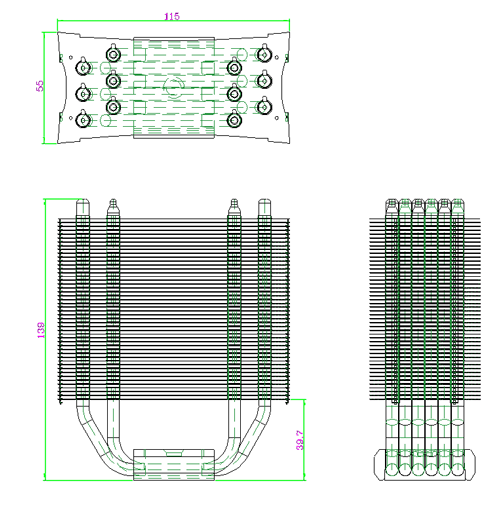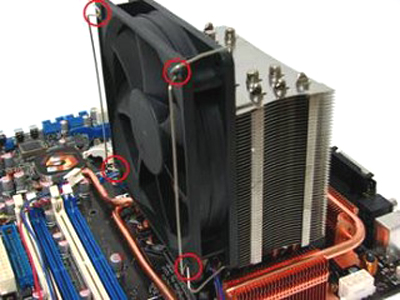Thermalright Ultima-90: Small Wonder?
by Wesley Fink on August 20, 2007 2:00 AM EST- Posted in
- Cases/Cooling/PSUs
There have been several coolers that have topped our air cooling benchmarks in recent months, and all of the best coolers have several things in common. The best are all based on heatpipe tower designs, they all feature side-blowing 120mm fans (and sometimes two 120mm fans in a push-pull configuration), and they are all relatively heavy and huge. It certainly appears that if you needed to dissipate more than 150W from your overclocked CPU that you clearly need a big and heavy cooler.
It has always been interesting to note that Thermalright competes exceptionally well using a slightly smaller cooler - just as wide but not nearly so deep as others. This reached the height of efficiency in the top-performing Thermalright Ultra-120 eXtreme, which is our current performance leader. The eXtreme is the same size as the very competitive Ultra-120, but it manages better performance with the careful design and placement of six heatpipes in the same Ultra-120 design.
We were reminded of this again in our last review of the smaller ZEROtherm BTF90, which uses a smaller 92mm fan and is selling for a lower price than the best. The BTF90 competes very well with the top coolers with very low noise. It isn't the most effective at cooling in our competition, but it's certainly a good choice without too much compromise in performance at the top.
Apparently Thermalright has been thinking in the same vein. We recently received a shipment from Asia containing a new Thermalright model, which they call the Ultima-90. The design is very similar to other Thermalright heatpipe towers, only as you might expect it comes in a slightly smaller package.

At first glance you may mistake the Ultima-90 for the current Ultra-90, which comes in both 775 and AMD versions. If you look closely, however, you will see that the Ultima-90 has six heatpipes instead of the four seen in the Ultra-90 design. Thermalright calls the design six heatpipes since it is six fully looped heatpipes. Other makers might refer to this as a 12-pipe design, since there are 12 riser pipes.
We shrugged our shoulders when we first saw the Ultima-90, since we assumed the size reduction would drop the Ultima-90 to another performance category. Thermalright then told us that in their testing the Ultima-90 could outperform many full-size 120mm heatpipe towers. That certainly piqued our interest. There is also the fan factor, since the high-end Thermalrights do not ship with a fan. The Ultima-90 provides two sets of fan clips.

One will mount 120mm fans on the small Ultima-90.

A second set of clips mounts a standard 92mm fan.
Since the Ultima-90 carries the same heatpipe setup as the top-performing Ultra-120 eXtreme and mounts 92mm and 120mm fans, our test configuration needs to look at the Ultima-92 with both a 120mm fan and a 92mm fan. How does the smaller and cheaper ($49.95 retail) Ultima-90 compete with the top guns in these two configurations?
It has always been interesting to note that Thermalright competes exceptionally well using a slightly smaller cooler - just as wide but not nearly so deep as others. This reached the height of efficiency in the top-performing Thermalright Ultra-120 eXtreme, which is our current performance leader. The eXtreme is the same size as the very competitive Ultra-120, but it manages better performance with the careful design and placement of six heatpipes in the same Ultra-120 design.
We were reminded of this again in our last review of the smaller ZEROtherm BTF90, which uses a smaller 92mm fan and is selling for a lower price than the best. The BTF90 competes very well with the top coolers with very low noise. It isn't the most effective at cooling in our competition, but it's certainly a good choice without too much compromise in performance at the top.
Apparently Thermalright has been thinking in the same vein. We recently received a shipment from Asia containing a new Thermalright model, which they call the Ultima-90. The design is very similar to other Thermalright heatpipe towers, only as you might expect it comes in a slightly smaller package.

At first glance you may mistake the Ultima-90 for the current Ultra-90, which comes in both 775 and AMD versions. If you look closely, however, you will see that the Ultima-90 has six heatpipes instead of the four seen in the Ultra-90 design. Thermalright calls the design six heatpipes since it is six fully looped heatpipes. Other makers might refer to this as a 12-pipe design, since there are 12 riser pipes.
We shrugged our shoulders when we first saw the Ultima-90, since we assumed the size reduction would drop the Ultima-90 to another performance category. Thermalright then told us that in their testing the Ultima-90 could outperform many full-size 120mm heatpipe towers. That certainly piqued our interest. There is also the fan factor, since the high-end Thermalrights do not ship with a fan. The Ultima-90 provides two sets of fan clips.

One will mount 120mm fans on the small Ultima-90.

A second set of clips mounts a standard 92mm fan.
Since the Ultima-90 carries the same heatpipe setup as the top-performing Ultra-120 eXtreme and mounts 92mm and 120mm fans, our test configuration needs to look at the Ultima-92 with both a 120mm fan and a 92mm fan. How does the smaller and cheaper ($49.95 retail) Ultima-90 compete with the top guns in these two configurations?










38 Comments
View All Comments
Wesley Fink - Monday, August 20, 2007 - link
The performance of the stock Intel Retail cooler also needs to be put in perspective. In our testing the Intel Retail HSF is stable to 3.73GHz at 1.50V. That translates into about 137W with an X6800 CPU.While early Intel Retail 775 coolers were very noisy, stock coolers since late Presller and through Core2 have been very quiet, as you can see in our noise measurements in reviews.
With a stock cooler performing this well, we think a cooler HAS to provide performance better than Intel Stock to persuade you to buy it. We could argue using your logic that the difference between the Intel stock of 3.73GHz and the top 3.94GHz is only 200 megahertz and so it is minor. The wattage difference, however, is between 137W and 166W, which is a significant difference in the ability of coolers to dssipate heat.
ssiu - Monday, August 20, 2007 - link
I have a serious question regarding this. 3.73Ghz is perfectly fine with me and I don't care for another 200Mhz. The louder noise of stock cooler is also okay with me. So that leaves the temperature difference of 71C for stock cooler versus (43C for Ultra-120 eXtreme, 47C for Ultima-90, 59C for NinjaB, 62C for Infinity, etc.) Does the stock cooler's higher temperature make the CPU die prematurely? Or is it a case of "the CPU is designed to withstand 71C; at 3.73Ghz, 71C may make it last 5 years instead of 10 years at 43C, but even at 71C it will become obsolete (too slow) before it will die"?Wesley Fink - Monday, August 20, 2007 - link
Intel shows a maximum recommended temp of 60.4C at 75W (stock) for the X6800 in their thermal design document at ftp://download.intel.com/design/processor/datashts...">ftp://download.intel.com/design/processor/datashts... However, 3.83 Ghz is about 137W and we really don't know the recommendations at these higher frequencies since they represent overclocks.It would seem reasonable to aim for lower than the max recommended temperature at stock speed if you are aiming for longevity of the CPU. That cahart can be found on p.85 of the Intel PDF linked above.
Wesley Fink - Monday, August 20, 2007 - link
Correction - 3.73GHz at 1.5V is about 135W - which is the max stable speed with the Intel stock HSF. Sorry for the typo.Jedi2155 - Monday, August 20, 2007 - link
To Coolerman:I had the Tuniq 120 for about 6 months on my E6600 setup, and although it was a great cooler and signifcantly cheaper than the Ultra 120 Extreme, it just isn't as good when all things are considered (size, noise levels, fan options) and the Ultra 120 extreme is worth the price difference IMO. The size made installation ever so much easier than the Tuniq and improvement in cooling (even with a cheap $7 thermaltake fan) was significant (went from 80 C Intel TAT to around 70 C).
I definitely think that you should recategorize the coolers, but instead of temperature, how about price range or probably best category SIZE.
I've had a number of issues during builds for friends, where the a certain cooler wouldn't fit (like a Tuniq 120 or the Ultra 120 Extreme) fit inside a case without significant modification (with a pair of pliers and remove a good section of the case).
That should help us decide better than just pure temperatures and overclock speed.
CZroe - Monday, August 20, 2007 - link
I think that sorting by value/prices is a bad idea. Have you looked for the actual prices? Anandtech's reported suggested prices and "actual" market prices have been FAR lower than I've been able to find in each cooler that interested me. I eventually just settled on the Ultra-120 Extreme and the same fan from Newegg and paid FAR too much.Perhaps the observed difference is because they keep getting price results for similar models (which complicated my own searching) or the only places that still carry some of these still have them because they always overcharged.
tom0099 - Friday, August 6, 2021 - link
http://google.com">googletom0099 - Friday, August 6, 2021 - link
<a href="https://google.com">google</a>